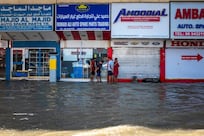While there is no universally accepted definition of hyperinflation, it is generally easy to spot. The noted economist Phillip Cagan drew a rough framework around the term in his 1956 article "The Monetary Dynamics of Hyperinflation", describing it as a monthly inflation rate of 50 per cent or more; the reality, though, is that it hardly needs a formal definition. By the time Zimbabwe axed 12 zeros from its currency last week, turning a trillion Zimbabwean dollars into one at a stroke, there was no dispute that the country had long been enduring a bout of hyperinflation.
At least 32 episodes of hyperinflation have so far been recorded. And as improbable as it sounds, Zimbabwe's struggle with inflation rates of over 500 quintillion per cent per year isn't even the worst on record. After the Second World War, Hungary's currency started losing its value at a meteoric rate. At one point, prices were doubling every 15.6 hours and the total value of all the pengõ in circulation was less than one US dollar. When Hungary introduced a new currency in 1946, one florint was exchangeable for 400 octillion pengõ.
So what causes hyperinflation? The jury is still out on this one, but economists believe it could be spurred by a number of possibly interrelated things: a rapid rise in the supply of money without an equal rise in demand for money, irresponsible government printing of money to maintain spending and pay off debts related to war, or a crisis of confidence among the populace in the currency as a store of value and a medium of exchange. Not surprisingly, hyperinflation often occurs during times of economic and political upheaval. Whatever its causes, hyperinflation can wreak devastating political and economic havoc. During an era of hyperinflation, people tend to abandon the local currency and move towards a barter system or towards foreign currencies that are perceived as more stable, which only serves to devalue the local currency further.
In Zimbabwe, for example, merchants have for months been accepting only US and South African currencies. Yet another terrible result of hyperinflation is the erosion of the value of savings. When the currency becomes worthless, the value of money saved over many years is suddenly erased. Naturally, hyperinflation also creates a disincentive to save and an incentive to spend currency as quickly as possible. If people know that prices will double virtually on a daily basis, they will spend what they get as soon as they can. That increases the velocity of transactions, leading to even more rapid inflation.
afitch@thenational.ae





